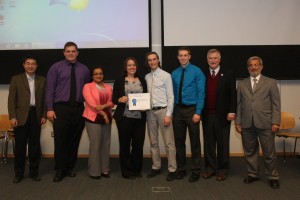

The winning Senior Design Challenge team accepts their honor for the Electro-Mechanical Stimulator for Cell Proliferation
After a beloved family member had a terrible fall, April Parrish saw firsthand why tissue engineering is so important.
“What would have been something minor for many was a painful ordeal for my husband's grandmother. She has diabetes and her sores don’t heal like ours do. The doctors tried all kinds of procedures, including using pigskin. She had visiting nurses for eight months,” said Parrish, a Winter 2015 UM-Dearborn graduate. “When you can’t heal, it’s traumatic.”
So when Parrish saw an opportunity to work on a project that could aid tissue research and cell creation through the College of Engineering and Computer Science 2015 Senior Design Competition, the dual mechanical and biological engineering major looked forward to the challenge.
“I know this is something that is needed and, if it works, I could be a part of something that can make a difference in someone’s life,” she said.
The annual SDC gives UM-Dearborn’s engineering students an opportunity to put into practice the skills and education they learned on campus, said CECS Dean Tony England.
Eight teams showcased their skills during the April event, covering topics ranging from pain process improvement to high-efficiency wireless charging system for electric vehicle applications.
“Some projects might be concepts designed by the students under the supervision of their faculty advisers. Other projects might be developed to meet specific needs within a company or the community,” England said. “Senior design gives our students the experience that enables them to enter the workforce prepared, able and ready to become valuable team members.”
For their project, Parrish and her teammates Aaron Connolly, Sean Rosalez and Jason Solocinski – lead by their adviser Mechanical Engineering Assistant Professor Gargi Ghosh – created an Electro-Mechanical Stimulator for Cell Proliferation.
The project, which won first place in the competition, is a two-part apparatus consisting of a control box and a bioreactor chamber that can easily fit into an incubator. It proposes using electrical and mechanical stimulation to fabricate cells.
In addition, since the cells will be grown in a sterile, controlled environment, researchers can observe cell response, depending on the amount of electrical and mechanical stimulation that is used.
The team was proud to accept the SDC’s first place honors, but they also were pleased to be a part of something that may have an impact beyond the campus.
Professor Ghosh said there is a great need for tissue engineering, which integrates the engineering principles with the fundamentals of life sciences.
Currently, 72 people die waiting for an organ transplant daily and the gap between the demand and supply of organs is expected to increase with the increase in life expectancy. Because of this – and the need for other human tissues like skin, which would have been beneficial for Parrish’s grandmother-in-law – bioengineers are researching ways to grow human cells in an in vitro lab environment that emulates an in vivo, or in body, experience.
Accomplishing this would lead to a lower chance of organ or tissue rejection.
“In the body, cells are regularly stimulated by various cues including mechanical and electrical stimulations,” Parrish said. “We are trying to mimic what the body does with our stimulator.”
And the team’s design – with its affordable price tag and portability – may help lead to a research breakthrough.
“Tissue engineering is believed to be the answer that will bridge the gap between need and supply,” Ghosh said. “In just one semester, these students designed and built a prototype, and were able to verify its functionality, up until cell testing. In theory, it will work. I was very impressed with what the students accomplished in such a short amount of time.”
The recent alumni, along with Professor Ghosh, aren’t done yet. The group is meeting throughout the summer, between jobs and families, to continue their work.
Their goal is to grow cells. And since they designed and built their stimulator in four months, they are confident that they can meet their goal. They are driven by the project’s potential – and the impact it can have on tissue research.
“Bioengineering, as a whole, is interesting because you can impact someone’s life directly with new medical technology,” Rosalez said. “I’m excited to see where this takes us.”


